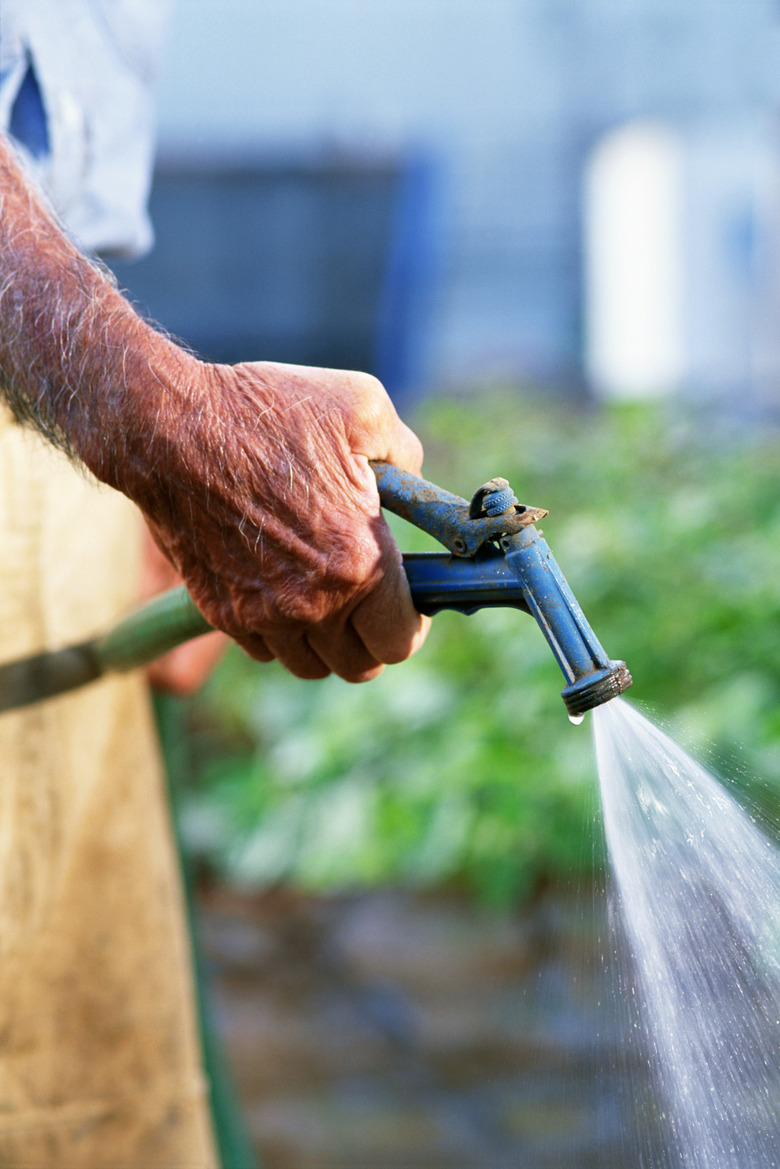Arborvitae Diseases & Cures
The arborvitae (Thuja spp.) group of shrubs and trees can thrive in U.S. Department of Agriculture plant hardiness zones 2 through 8, depending on the arborvitae you choose and the growing conditions on your property. Some natural browning and foliage-dropping is natural, especially in the fall. If browning persists or spreads, however, your tree may be diseased and in need of treatment.
Step 1
As the name suggests, tip blight stays mainly contained to the ends of branches. The discoloration is initially light brown and gradually turns a darker brown. You may also see raised black dots on the tips. To control this disorder if it reappears even after pruning, keep the tree's soil from drying out. Wrapping the tree in burlap also prevents the winter damage that encourages tip blight. Apply a copper spray to additionally protect the tree from tip blight. To use copper for tip blight, blend 3 1/3 tablespoons of copper sulfate with 10 tablespoons hydrated lime in 1 gallon of water. Spray your arborvitae with this copper solution in early spring and in the fall, concentrating on the tree's outer branches.
Step 2
- As the name suggests, tip blight stays mainly contained to the ends of branches.
- Apply a copper spray to additionally protect the tree from tip blight.
Twig Blight
Step 1
Two main types of twig blight occur on arborvitae, caused by the fungal pathogens Kabatina thujae and Phomopsis juniperovora, respectively. Kabatina twig blight mainly occurs on new branches, but both diseases can infect arborvitae at the same time. To add to the confusion, the symptoms are essentially the same. The tips turn dark gray or brown and die back, and entire branches can eventually become infected. Raised black dots can also appear at the juncture of living and dead wood. Each pathogen responds to different chemical sprays. But unless you're a trained arborist, the symptoms are so similar that the differences are often detectable only at a microscopic level. It's best to use the basic control measure of removing dead limbs or branching twigs where symptoms occur.
Step 2
- Two main types of twig blight occur on arborvitae, caused by the fungal pathogens Kabatina thujae and Phomopsis juniperovora, respectively.
- Kabatina twig blight mainly occurs on new branches, but both diseases can infect arborvitae at the same time.
Root Rot
Step 1
In regions in which humidity and rainfall aren't general concerns, blight is less likely to be a cause of arborvitae disease. Instead, root rot from overwatering, deep planting or poor drainage can lead to such symptoms as browning leaves, dead branches or tree tops, as well as tree death. Watering less frequently may be enough to correct root rot in its early stages. If the problem with an established tree is soil or planting too deeply, there may be no cure other than to use better practices with replacement trees. Plant on raised hills or berms if you have heavy soil, and take care to dig the holes no deeper than the size of their root systems.
Canker Disease
Step 1
You may see canker disease — sunken areas which may also be discolored, oozing resin or surrounded by raised, callus tissue — on either the branches or trunk of your arborvitae. Foliage may also turn brown on branches with cankers on them. If the canker disease is confined to the branches, the best treatment involves removing the infected limbs. There is little you can do if the cankers appear on the trunk, other than monitoring the spread to determine if the tree is still alive or if it needs to be replaced with a canker-resistant arborvitae cultivar.
Step 2
- In regions in which humidity and rainfall aren't general concerns, blight is less likely to be a cause of arborvitae disease.
- There is little you can do if the cankers appear on the trunk, other than monitoring the spread to determine if the tree is still alive or if it needs to be replaced with a canker-resistant arborvitae cultivar.
References
- Washington State University Extension: Ailing Arborvitae
- University of California IPM: Arborvitae (Canker)
- Penn State College of Agricultural Sciences: Arborvitae Diseases
- Sanco: Copper Sulfate Fact Sheet
- Missouri Botanical Garden: Thuja Selections
- Ohio State University Extension: Arborvitae for the Home Landscape
